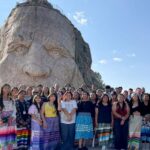It’s an evening in 1531, in the city of Venice. In a printer’s workshop, an apprentice labors over the layout of a page that’s destined for an astronomy textbook—a dense line of type and a woodblock illustration of a cherubic head observing shapes moving through the cosmos, representing a lunar eclipse. Like all aspects of book production in the 16th century, it’s a time-consuming process, but one that allows knowledge to spread with unprecedented speed.
Five hundred years later, the production of information is a different beast entirely: terabytes of images, video, and text in torrents of digital data that circulate almost instantly and have to be analyzed nearly as quickly, allowing—and requiring—the training of machine-learning models to sort through the flow. This shift in the production of information has implications for the future of everything from art creation to drug development.
But those advances are also making it possible to look differently at data from the past. Historians have started using machine learning—deep neural networks in particular—to examine historical documents, including astronomical tables like those produced in Venice and other early modern cities, smudged by centuries spent in mildewed archives or distorted by the slip of a printer’s hand.
Historians say the application of modern computer science to the distant past helps draw connections across a broader swath of the historical record than would otherwise be possible, correcting distortions that come from analyzing history one document at a time. But it introduces distortions of its own, including the risk that machine learning will slip bias or outright falsifications into the historical record. All this adds up to a question for historians and others who, it’s often argued, understand the present by examining history: With machines set to play a greater role in the future, how much should we cede to them of the past?













